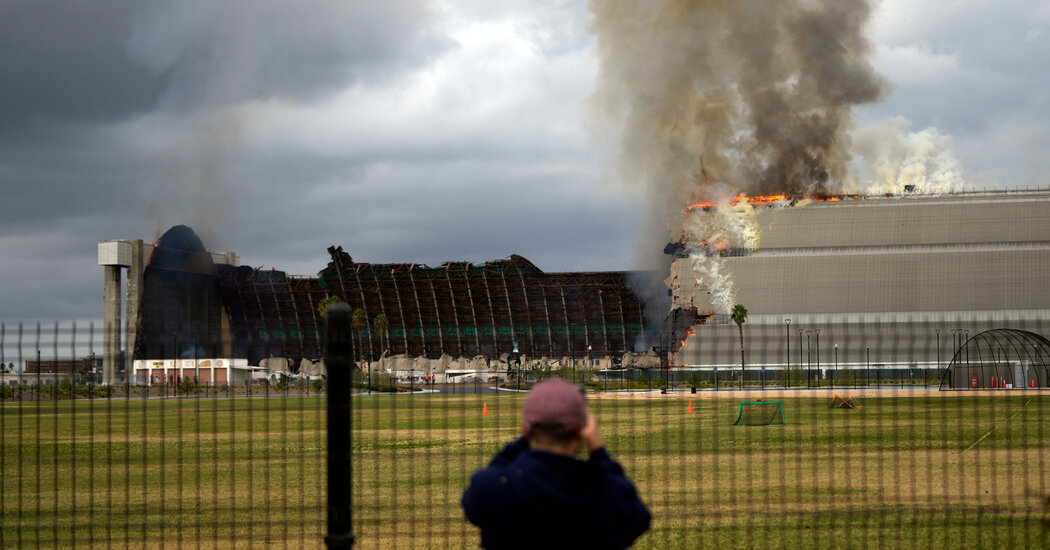A fire on Tuesday destroyed a cavernous wooden blimp hangar in Tustin, Calif., that played a pivotal role during World War II, the authorities said.
Chief Brian Fennessy of the Orange County Fire Authority said at a news conference on Tuesday morning that more than 70 firefighters had responded at about 1 a.m. to try to contain the fire in one of two colossal hangars at the former Marine Corps Air Station Tustin.
After their initial efforts failed to extinguish the fire in the north hangar, Chief Fennessy said, the fire authority deployed three helicopters to douse the large domed building from above, a method more typically used to fight large-scale wildfires.
But that strategy also failed, prompting officials to settle on allowing the structure to burn rather than put more firefighters at risk, Chief Fennessy said.
At 17 stories tall, 1,000 feet long and 300 feet wide, the hangars are among the largest wooden structures built in the 20th Century.
“We can’t get close enough to that building without concerns of it collapsing on our firefighters,” Chief Fennessy said, adding, “Our use of aircraft on a structure like this, that’s extraordinary.”
No injuries were reported, and the cause of the fire remained under investigation on Tuesday, the authorities said. The north hangar was “typically empty,” Tustin’s mayor, Austin Lumbard, said at the news conference.
Officials noted at the news conference how upsetting it was to see a building with such a history wither away in flames, especially since so many local residents had ties to the hangar, whether because relatives had once worked at the camp or simply because they viewed the enormous structure with reverence.
The structures were also used as filming locations for major Hollywood productions, The Los Angeles Times reported. Several World War II films, including “Pearl Harbor” (2001), used the vast space of the north hangar. Sci-fi TV shows and movies also took advantage, with the 2009 “Star Trek” reboot using it as a futuristic place to store space shuttles. “The X-Files” turned the south hangar into a meeting ground for government officials and extraterrestrials in 1999.
As of late Tuesday morning, sections of the hangar were beginning to collapse. Videos and photos posted on social media by the fire authority showed flames engulfing crisscrossed wooden beams, with a portion of the blackened roof tumbling down and releasing a plume of ash.
“It’s a sad day for the city of Tustin,” Chief Fennessy said, noting that the landmark had long served as an emblem of the city’s contributions during World War II.
Officials in Tustin, a city of around 79,000 residents about 34 miles southeast of Los Angeles, had recently been trying to preserve the hangar and had been in contact with the U.S. Navy, which owns the building, Mr. Lumbard said.
The base was built in 1942 as the Santa Ana Naval Air Station and housed blimps that were “used to patrol America’s coastline primarily to watch for enemy submarines,” according to the Tustin Area Historical Society.
In 1951, the base was reactivated to support the military during the Korean War, becoming the first air facility developed solely for helicopter operations. The base was used for Marine Corps helicopters in the 1990s before it closed in 1999.
The north hangar and the south hangar were added to the National Register of Historic Places in 1975.





